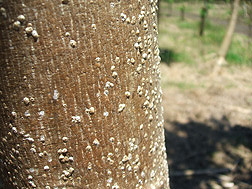This page has been archived and is being provided for reference purposes only. The page is no longer being updated, and therefore, links on the page may be invalid.
Read the magazine story to find out more. |
|
|
Pesky White Peach Scale Targeted in Tropical Studies
By Marcia WoodJuly 17, 2009
Hawaii’s welcoming “aloha” spirit isn’t really meant for the white peach scale. This troublesome insect attacks not only its namesake—peaches—but also many other crops, including Hawaii’s famed papaya trees.
Known to scientists as Pseudaulacapsis pentagona, the scale first showed up in Hawaii in 1997. To stop its spread, Agricultural Research Service (ARS) scientists in Hawaii are investigating the use of a tiny wasp to attack and kill the scale. ARS research entomologists Peter Follett and Robert Hollingsworth and University of Hawaii postdoctoral researcher Gabor Neumann are collaborating in the work. They’re based at the ARS U.S. Pacific Basin Agricultural Research Center in Hilo, Hawaii.
The adult scale is about one-eighth-inch long, and is referred to as “armored” because of its protective shell. But the armor doesn’t stop the wasp, called Encarsia diasapidicola. The female wasp, which is many times smaller than the scale, can slip an egg under the armor and into the scale. The egg hatches into a nearly microscopic, worm-like larva that slowly kills the scale by feeding on its innards.
In laboratory tests, the scientists have shown that the wasp, which is harmless to people, pets and livestock, also doesn't pose a threat to "nontarget" scales. Those nontargets include the palm scale—native to Hawaii—and the false oleander scale.
The scientists must have this evidence in order to win government permissions to turn the helpful wasp loose in Hawaii.
The idea of using the wasp to kill the scale isn’t new, but the Hawaii team is the first to investigate this science-based strategy to control the scale in The Island State.
Read more about this research in the July 2009 issue of Agricultural Research magazine.
ARS is the principal intramural scientific research agency of the U.S. Department of Agriculture.

